Endless nights livened up by candles and string lights underneath a galaxy of stars and streaking auroras. Pastel blue light washing over snow-capped mountains with not a tree in sight. Brilliant sun shining day and night above snow-covered tundras, pristine nature marred only by a few snowmobile tracks showing the path to adventure.
Believe it or not, these are all the same season, just different flavors. Welcome to Svalbard in winter.
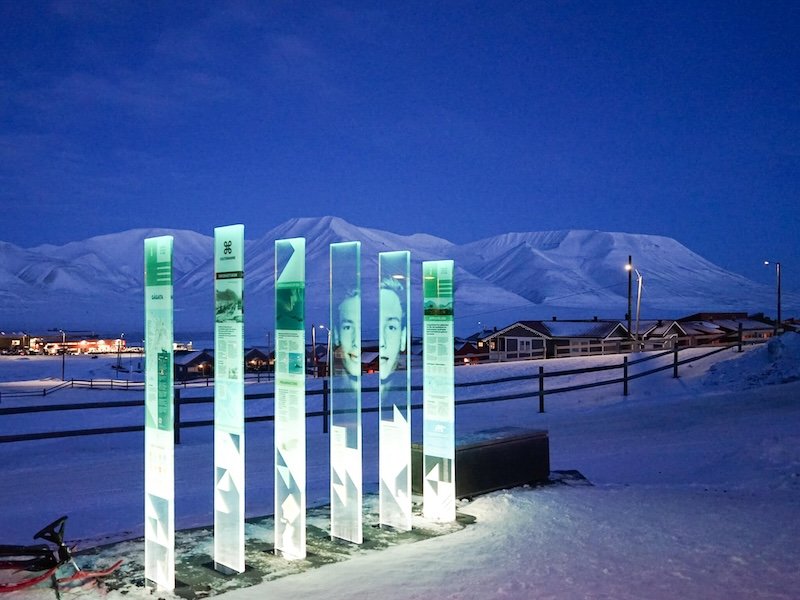
| 🏔️ Planning your winter Svalbard trip in a hurry? Here are my quick picks! ❄️ Best Winter Activities 1. Snowmobile safari to an ice cave in a glacier 2. Eastern Spitsbergen snowmobile safari with chance of polar bears 3. Arctic wildlife photography safari 4. Budget-friendly aurora chase by car 🛏️ Best Places to Stay 1. Svalbard Hotell Polfaren (mid-range, where I stayed and recommend!) 2. Funken Lodge (slightly pricier but beautiful boutique option) 3. Coal Miners Cabins (budget rooms with shared bathroom) |
Ever since I first saw Svalbard on a map, tucked in a top-most corner near the seam of a page, and truly processed how remote it was, I wanted to go. At this age, I knew nothing of polar nights and midnight suns, or even polar bears. I just knew that it was far and that I liked the idea of far.
Then I fell in love with the Arctic, slowly but surely over many visits: first a trip to Kiruna and Abisko, later a trip to Tromsø, next a trip to Rovaniemi, and then back to the Norwegian Arctic again. And Svalbard? Svalbard is as Arctic as it gets, and winter there is an experience like no other.
I visited Svalbard in February, right at the tail end of Northern Lights winter but before the dark season properly came to an end.
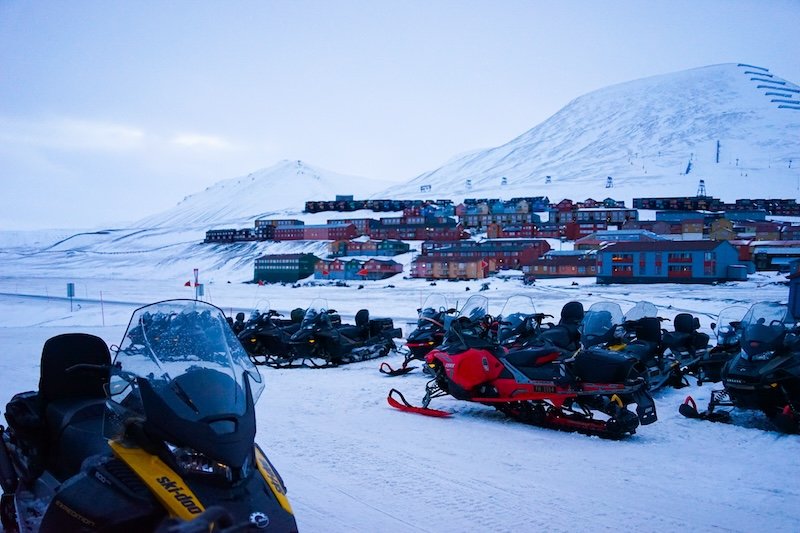
As a result, I got to experience a nice mix of many of the activities that make Svalbard winter so unique: Northern lights tours, snowmobile rides, and gorgeous pastel light.
Here are my favorite activities to do in Svalbard in winter, and some that I want to do on a future visit.
You really need to visit Svalbard at multiple times throughout the year to properly do everything on your Svalbard bucket list, because the seasons in Svalbard are each so different and that really impacts what activities you can do.
When is Winter in Svalbard?
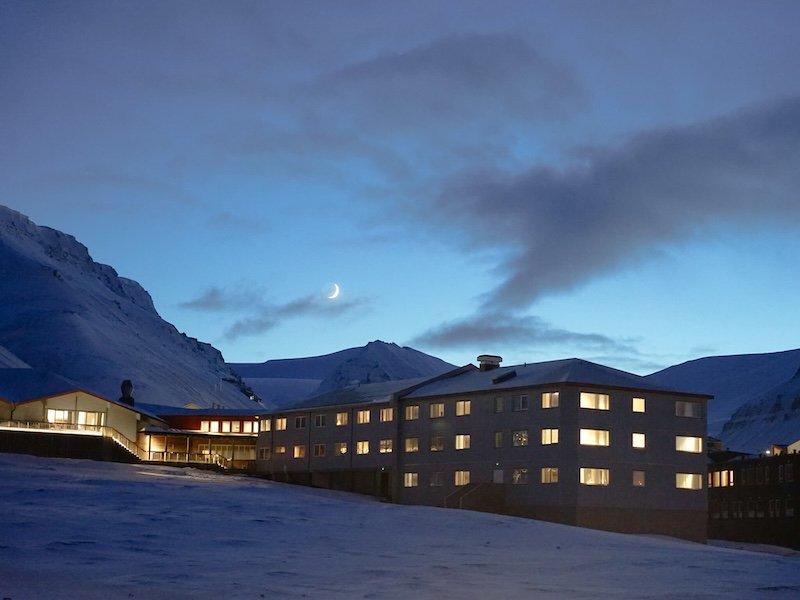
How long does winter last in Svalbard? Quite a long time, about two-thirds of the year. Only the period between May 17 and September 30 is considered Polar Summer by locals. Even part of the Midnight Sun season coincides with what is still considered “Sunny Winter”!
Winter in Svalbard is divided into two main parts: dark winter (which they’ve tried to rebrand as “Northern Lights Winter”) and sunny winter. But dark winter, too, can be divided into the true Polar Night, which has 24-hour darkness and two periods of Twilight preceding it.
The Twilight period lasts from October 1 through November 10 and again from February 1 to 28.
February’s twilight hours are called the “blue hours” for the beautiful azure light mimicking daylight, even though the sun never rises above the horizon.
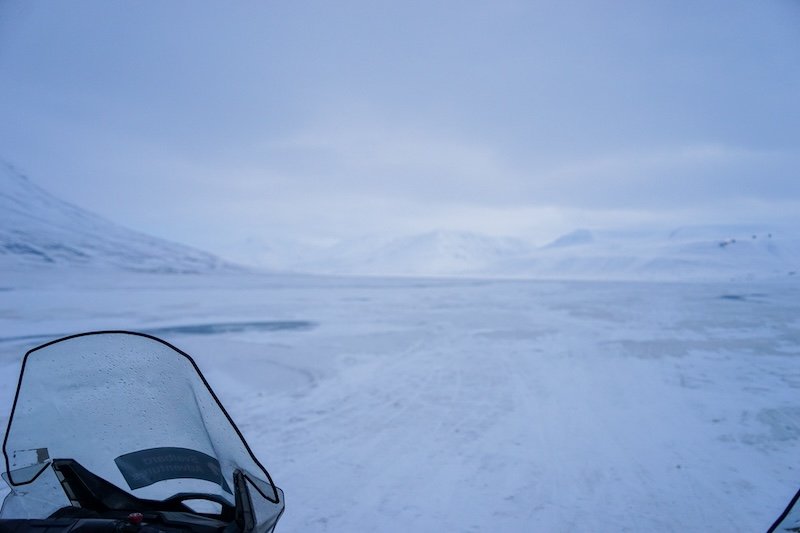
Here’s a quick breakdown of the sub-seasons of winter and when they fall. Note that this has a lot more to do with light conditions (and thus what activities are available to you!) than it does with temperatures.
- October 1 through November 10: Northern Lights Winter (Twilight Period, Part 1)
- November 11 through January 31: Northern Lights Winter (Polar Night)
- February 1 through February 28: Northern Lights Winter (Twilight Period, Part 2)
- March 1 through May 16: Sunny Winter (note: Midnight Sun begins around April 18)
Winter Temperatures in Svalbard
Northern Lights Winter
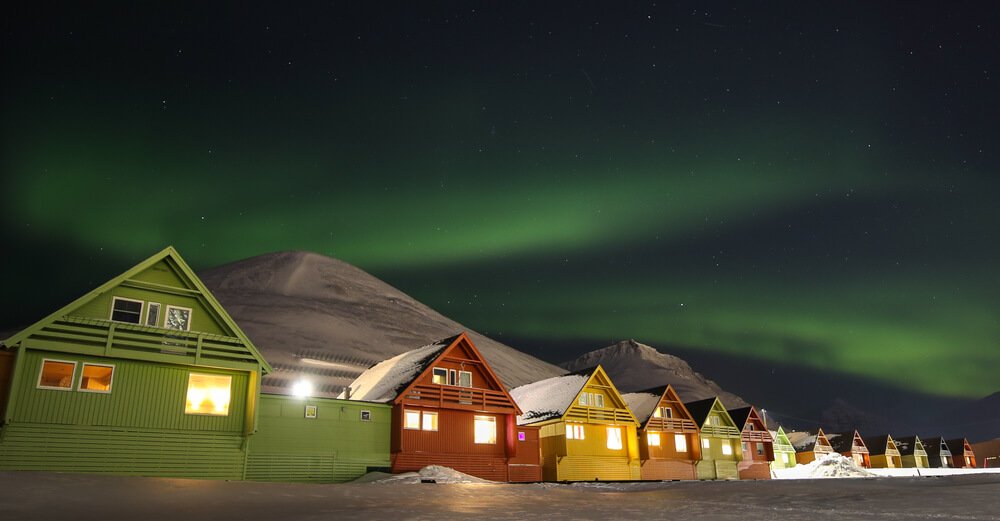
While these are the average highs and lows, extreme temperatures are possible during storms.
Icy cold temperatures of -20° C (-5° F) are frequent in the winter, and on my February trip, the high temperature one day was -15° C (5° F), but it felt much colder due to the windchill!
- October: Average highs of 0°C (32°F), average lows of -4°C (25°F)
- November: Average highs of -3°C (27°F), average lows of -8°C (18°F)
- December: Average highs of -5°C (23°F), average lows of -10°C (14°F)
- January: Average highs of -5°C (23°F), average lows of -10°C (14°F)
- February: Average highs of -6°C (21°F), average lows of -11°C (12°F)
Sunny Winter
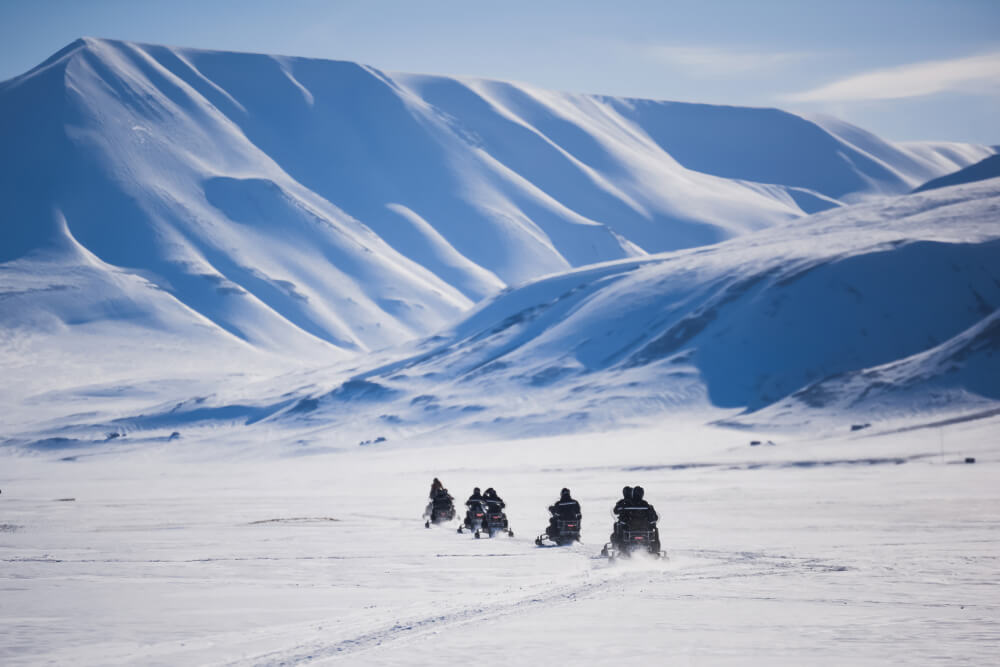
While these are the average highs and lows, extreme temperatures of up to -35° C (nearly -40° F) are possible during winter storms. Temperatures of -20° C (-5° F) are frequent, especially in March.
Windchill can significantly impact the real feel of the winter conditions. It can seriously increase your risk of frostbite, so be incredibly cautious when doing outdoor activities during colder seasons.
Note that while sunny compared to other parts of the winter in Svalbard, March is typically the coldest month of the year.
- March: Average highs of -8°C (18°F), average lows of -14°C (7°F)
- April: Average highs of -5°C (23°F), average lows of -10°C (14°F)
- May: Average highs of 1°C (34°F), average lows of -3°C (27°F)
15 Cool Things to Do in Svalbard in Winter

This guide to Svalbard winter activities is a little unique in that I’ve also included when you can do each activity.
The winter season in Svalbard is broken into so many unique parts, so I don’t want you to be disappointed if, say, you arrive at the end of March and realize you’ve missed aurora season or you arrive in December and snowmobile season hasn’t started yet.
Svalbard’s winter covers many different conditions: there are days when you can see the aurora borealis literally in the middle of the day, and there are days when you won’t see a moment of darkness at all.
Visit an ice cave in a glacier
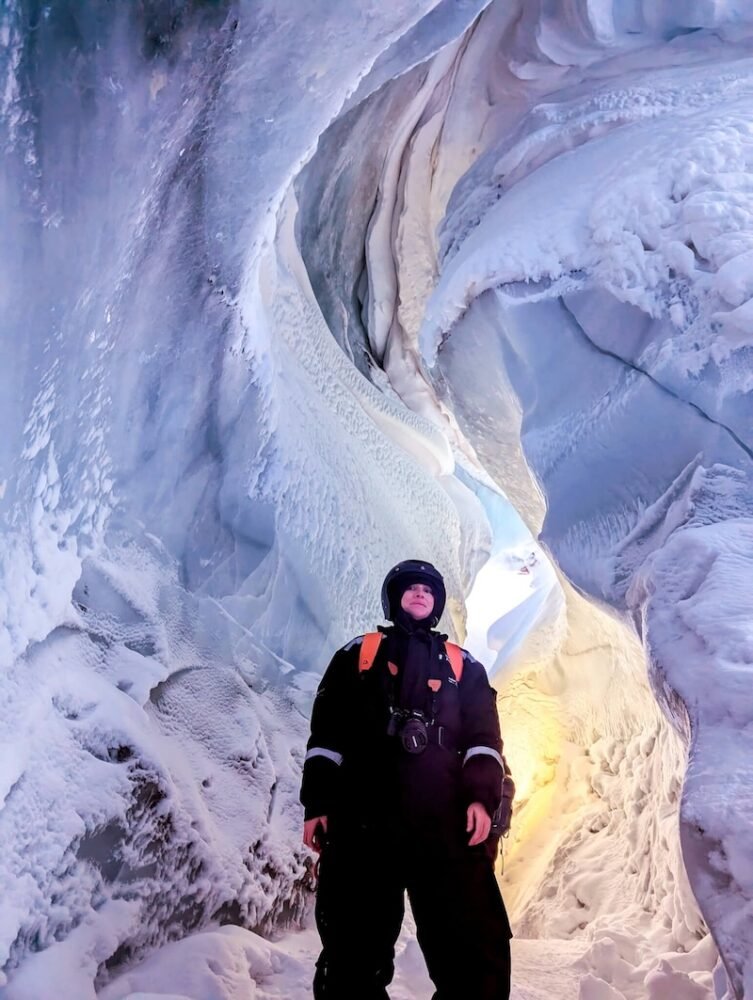
- When: Mid-February through mid-May
Visiting an ice cave by snowmobile was my favorite Svalbard tour I did during my time there in February!
This is an adventurous tour, not for the faint of heart. We got on our snowmobiles and drove more than 50 kilometers to and from an ice cave near the Tellbreen Glacier, deep into the heart of Spitsbergen.
It was only my second time driving a snowmobile but I felt safe and pretty confident as we navigated first through the huge valley expanse of Adventdalen before later zig-zagging our way through slightly more treacherous terrain to get to the interior where we could find the glacier.
Once we reached our endpoint, our guide made sure the area was safe and led us down a rickety ladder into a beautiful ice cave, crystals glittering in the glow of our headlamps.
It was a magical experience seeing the glacial ice and the air bubbles that had been trapped inside of it for thousands of years, water just as pure as they were the day it froze.
Learn polar history at the Svalbard Museum

- When: All winter
One of my favorite places in Svalbard, the newly-renovated Svalbard Museum, is equally educational and entertaining. You’ll learn all there is to know about Svalbard here, from its geological roots stretching back millions of years to its more recent history of exploration (and exploitation).
You’ll learn about its fascinating history as both a whaling station and fur trapping hub, as a base for scientific research and expeditions, and its time as a major hub for mining… before now shining as an icon of sustainable tourism in the Arctic.
Go on an Arctic wildlife photography tour
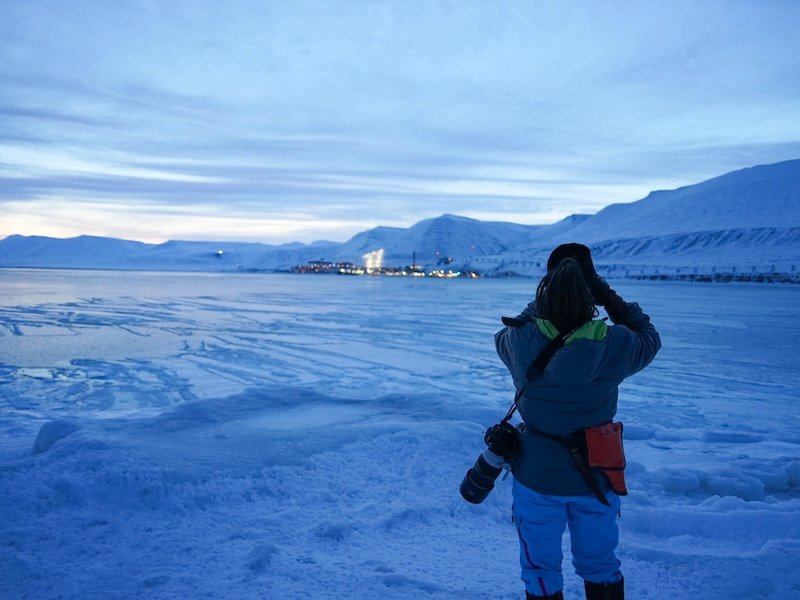
- When: October, February-May (not available during Polar Night)
Here’s the thing about visiting Svalbard: even if you fly in as an independent tourist, you can see very little of the Svalbard archipelago (basically, just a few streets in Longyearbyen) without an organized tour.
Why? Because it’s not permitted to leave the settlement of Longyearbyen without a rifle, and that’s not something the average tourist can obtain while traveling to Svalbard on a quick trip.
So doing a car-based tour like this Arctic wildlife photography safari is the perfect way to see the nature around Longyearbyen as much as the roads will allow.
Admittedly, there’s not as much wildlife in the winter as there is in the summer. Expect to see a handful of Svalbard reindeer—they’re pretty much everywhere on the island of Spitsbergen.
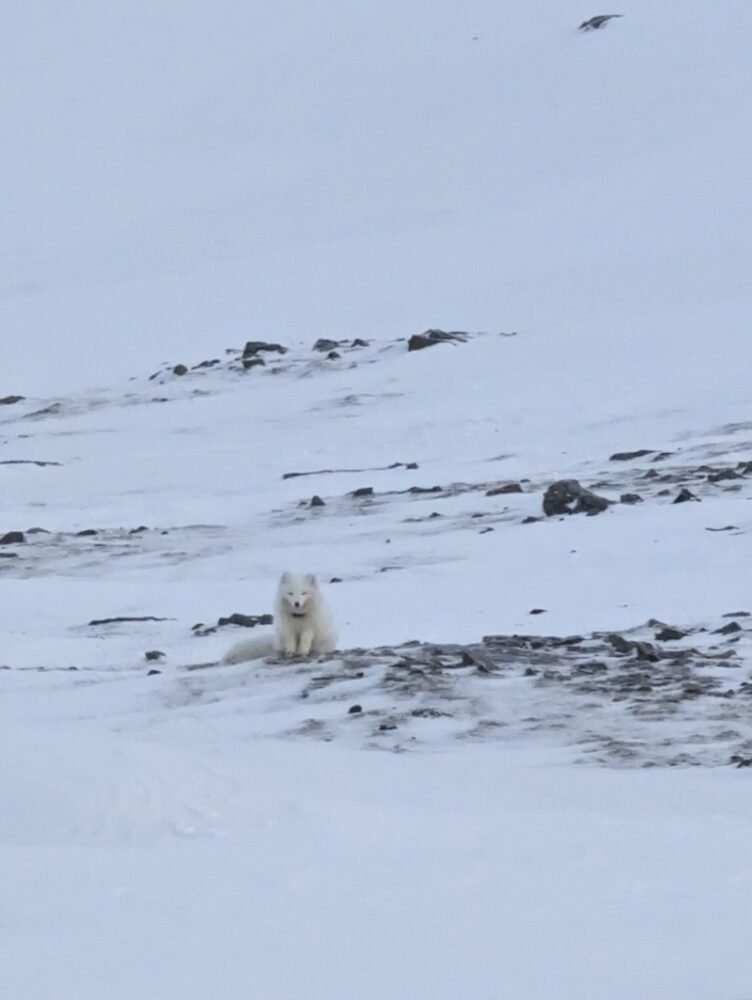
If you’re lucky, you’ll see an Arctic fox (we saw two!) and possibly a walrus (we saw one way out in the water).
Note that many of the Arctic foxes near Longyearbyen wear a collar around their necks, which helps researchers at the local university identify them and track the health of the population. As cute as they are, they’re definitely no one’s pets!
Most birds migrate away from Svalbard in the winter months. Still, we were lucky enough to see some cool Svalbard rock ptarmigans.

This is a unique and very hardy species that lives on Svalbard year-round (this fascinating bird literally grows feathers on its feet to act like snowshoes—wild, right?), as well as some common eiders out in the water.
This was one of my favorite activities I did in Svalbard in winter because it gave me a sense of the area around Longyearbyen and what would be your backyard if you were a local.
Check out the unique Global Seed Vault
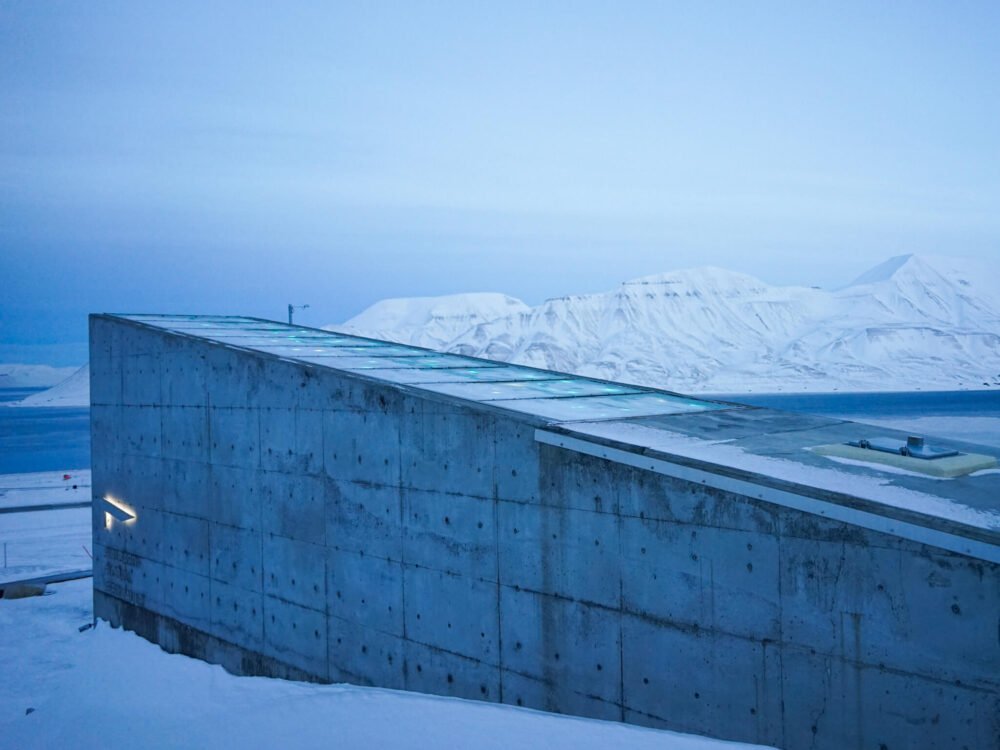
- When: All winter, but better in twilight or daylight
Did you know that Svalbard is home to a ‘doomsday vault’ of more than 1 million unique species of seeds — representing nearly every country on planet Earth?
The Svalbard Global Seed Vault was chosen to be located here for two main reasons: one, Svalbard is demilitarized and far from the European mainland so it’s unlikely to be affected in the case of war; and two, the permafrost (theoretically) keeps the seeds at a safe and stable temperature in case of power outages.
Eventually, this massive vault can hold up to 4.5 million different seeds, and in the event of some big catastrophe, it can possibly help us repopulate the world’s biodiversity in food supply.
Of course, you can’t actually enter the building… that’s humanity’s future at stake, they’re not going to let some random tourists in! But it’s still quite cool to see, and it looks even more otherworldly surrounded by snow.
Visit the world’s northernmost brewery, Svalbard Bryggeri
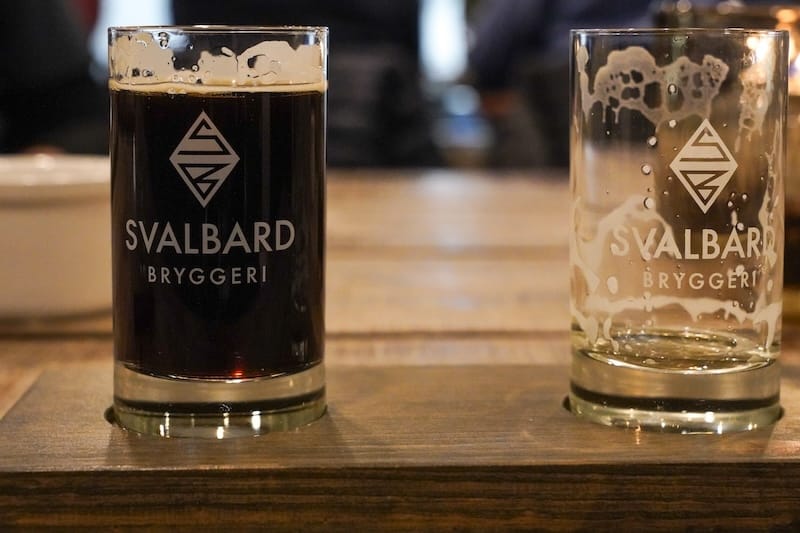
- When: All winter
While Mack Brewery in Tromsø stubbornly (and erroneously) claims to be the world’s northernmost brewery, that honor actually belongs to Svalbard Bryggeri, which you can visit all year round in Svalbard.
Unfortunately, due to health reasons, I’ve had to quit alcohol and thus didn’t go to visit during my trip to Svalbard…
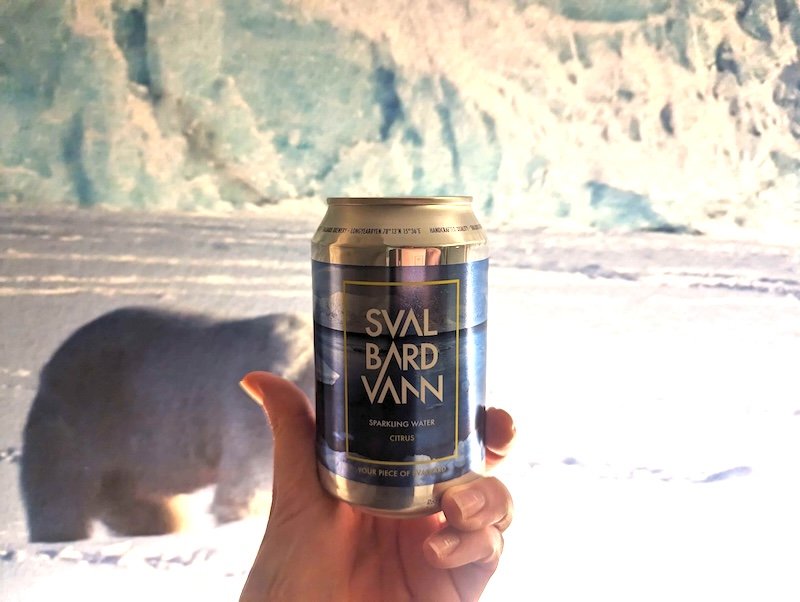
… but I did taste their delicious carbonated water, which you can pick up at the Svalbardbutikken and restaurants all over Longyearbyen.
If you’re curious about visiting the brewery, my friend Megan has written a comprehensive guide.
Have coffee and cake in a lovely husky cafe
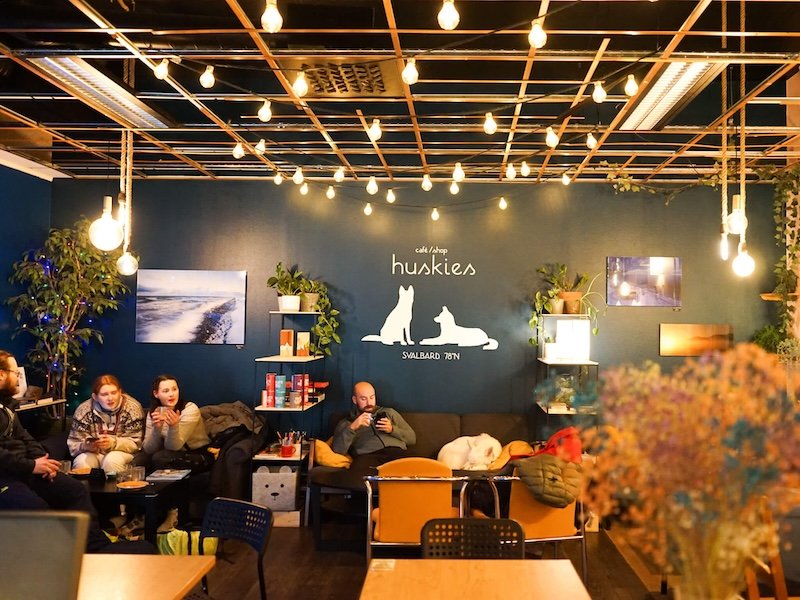
- When: All winter
One of the things I was most excited to do in Svalbard in winter was visit Cafe Huskies, a cute little coffee shop and bakery staffed by a team of retired sled dogs (oh, and some humans who help take orders).
Their coffee was absolutely perfect and they had a really excellent selection of pastries and cakes. Megan had a delicious caramel cheesecake and I had an otherworldly raw cake with all sorts of nuts, agave, and chocolate.
They also have sandwiches and (somewhat confusingly but I’m sure deliciously) poké bowls pre-made that you can grab for a light lunch.
There’s also a small gift shop where you can grab husky-related and Svalbard-related gifts!
Grab chocolates from the world’s northernmost chocolate factory

- When: All winter
You’ll find when visiting Svalbard that almost everything is labeled with the superlative “northernmost” — this is the northernmost lamppost in the world! — and so on.
And mostly, I just nod along, as it’s not much of a contest when you have only Ny-Ålesund north of you. But I find a hard time being blasé about anything chocolate-related.
Fruene makes their own chocolates at 78° N, so it can boast exactly that. It’s also a lovely little café and wine bar! This is another great place to grab some souvenirs and also a cup of coffee or light lunch.
Enjoy the cozy pub and restaurant scene of Longyearbyen
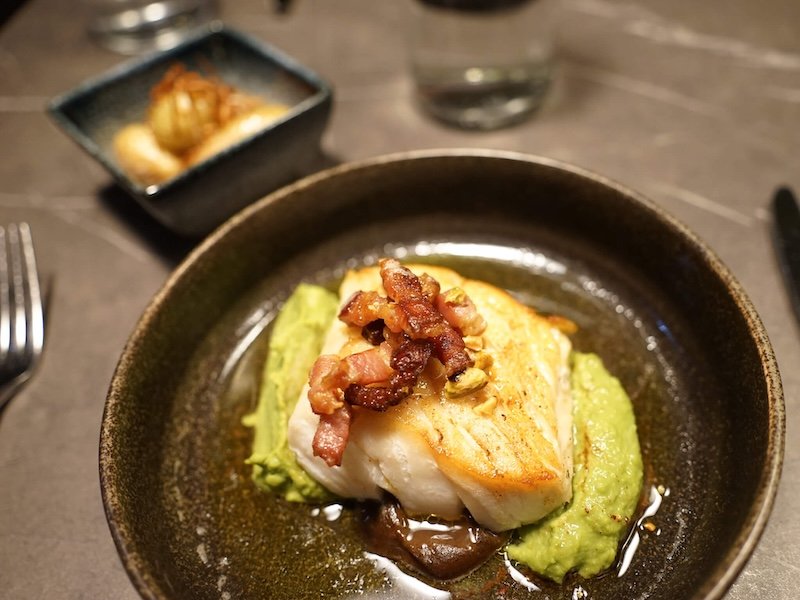
- When: All winter
I was pleasantly surprised by just how lovely the restaurant scene in Longyearbyen is!
You’d think that this small settlement on an Arctic archipelago wouldn’t have a ton to offer in the food department, but considering the town’s small size, there was a very wide range of delicious places to eat.
You can have everything from a simple soup of the day at Kroa for about 160 NOK (about USD 15) to an exquisite multi-course meal at Huset, the best fine dining restaurant on the island, where an exquisite tasting menu costs 2200 NOK (about USD 206).
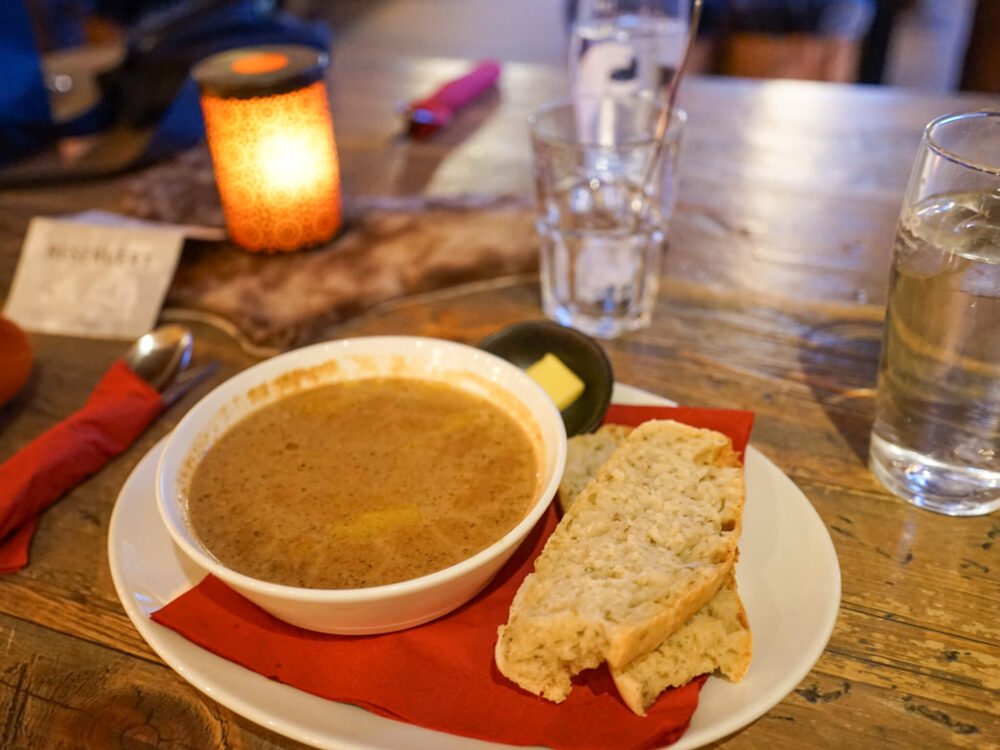
For something in the middle, try dining at Polfaren in Hotell Svalbard. It has delicious mains roughly in the 300-400 NOK range (that’s about 28-37 USD) and is a nice place to enjoy a more substantial meal without seriously breaking the bank.
Other recommended restaurants:
- Stationen for delicious and affordable burgers around 200-250 NOK (about 18-23 USD)
- Funktionærmessen for good value 4-course tasting menus (850 NOK or around 80 USD) and main courses around 400 NOK (37 USD)
- Gruvelageret for high-concept 4-course tasting menus (1250 NOK or around 115 USD)
Search the sky for the Northern lights

- When: October through mid-March
To be honest, seeing the Northern lights in Svalbard isn’t the most straightforward place to see the aurora.
Svalbard is located so far north of the Arctic Circle that it’s outside of the optimal “aurora zone,” and daylight hours shift so rapidly that the aurora season is about two months shorter in Svalbard than in other places like Abisko, Rovaniemi, and Tromsø.
That said, you have the unique opportunity to see the aurora in the middle of the day during polar night, so that certainly makes up for it. It’s one of the most special things about the Polar Night time of the year!
You can sometimes see the Northern lights as you’re just walking around Longyearbyen if there is a lot of solar activity and you have a clear sky.

But there are other ways to see the Northern lights in Svalbard, such as going on a dog-sledding tour under the night sky, going on a car chase tour of the Northern lights, visiting a wilderness camp, or going snowmobiling during dark skies, hoping the lights appear overhead.
Here are a few of the different Northern lights experiences you can try!
- Northern lights chase by snowmobile (this is what I did but unfortunately we weren’t able to see the Northern lights this night)
- Northern lights chase by car (great budget option)
- Northern lights snowmobile tour to aurora camp (a 7-hour snowmobile tour to the remote Sassendalen Valley — halfway across Svalbard!)
Visit the North Pole Expedition Museum

- When: All winter
Admittedly, this museum could use a facelift, as it’s a bit hard to navigate and pales compared to the Svalbard Museum. But that’s not for lack of the lovely staff’s efforts, who will do their best to tell you the best way to tackle this museum, which feels like it’s been put together by a hoarder rather than a curator.
I was expecting something similar to the Polar Museum in Tromsø, one of my favorite museum experiences. However, it’s a bit scatter-shot, with a disproportionately large section of the museum dedicated to airship exploration and rescue missions, as well as challenging the varying accounts of people who claimed to be the first to reach the North Pole.
Despite some of the shade I’m throwing towards the museum, I think it’s worth going. There are only a few museums in Longyearbyen, so you might as well enjoy them!
I learned even more than I previously knew about Roald Amundsen, one of the greatest polar explorers, and his attempts to reach the North Pole — and also about many polar blunders of other explorers along the way.
Admire the brightly-colored houses of Longyearbyen

- When: Year-round, but best lighting in October, February-May
Of course, the brightly-colored Longyearbyen houses in candy-bright colors are there all year round… but during the darkest of the winter months, you won’t really be able to admire them in all their colorful glory the same way you would once Twilight Season or Sunny Winter rolls around.
The hillside neighborhood, Lia, is one of the most spectacular parts of Svalbard’s architectural scene. With beautifully painted rows of housing, it has earned the nickname “spisshusene,” the pointed houses, for their shape as well as their brilliant color.
The idea behind these colorful houses was the brainchild of Ingvald Ohm, who then worked with the color designer Grete Smedal — a female designer from Bergen (a city that knows a thing or two about color) to create a color palette that complemented Svalbard’s tundra and its ever-changing seasons.
She also considered how the snow-covered landscape would look with these colors, as well as how the colors would look in the dark of the Polar Night — pretty cool, huh?
She eventually chose colors in red, yellow, green, and teal to represent the naturally-occurring colors of the Svalbard tundra. Those colors are now part of the government’s official color scheme for all buildings in Longyearbyen and are now codified into Svalbard’s building codes.
I learned all of this cool information from the Arctic University of Norway’s records — you can read more about it here.
Take a snowmobile safari to Eastern Spitsbergen

- When: Mid-February through mid-May
I didn’t get a chance to do this tour because I left Svalbard before these tours began again, but my friend Megan stayed a few days longer than I did. She enjoyed this tour so much that she said it’s the best thing she ever did in Svalbard — and she’s visited five times!
This tour is called the Polar Bear Snowmobile Safari from Longyearbyen but you should be aware that it is not a true safari where they track and try to find polar bears.
That is strictly illegal on Svalbard, and for good reason. Polar bears are extremely dangerous to humans and also vulnerable to extinction. An interaction, particularly on land, between tourists and polar bears should be avoided, not sought out.
However, the largest concentration of polar bears in Svalbard can be found on the Eastern coast of Spitsbergen island. This is because this side of the island has far lower average temperatures than the rest of Spitsbergen because it is not impacted by the Gulf Stream, which brings warmer, more temperate weather.
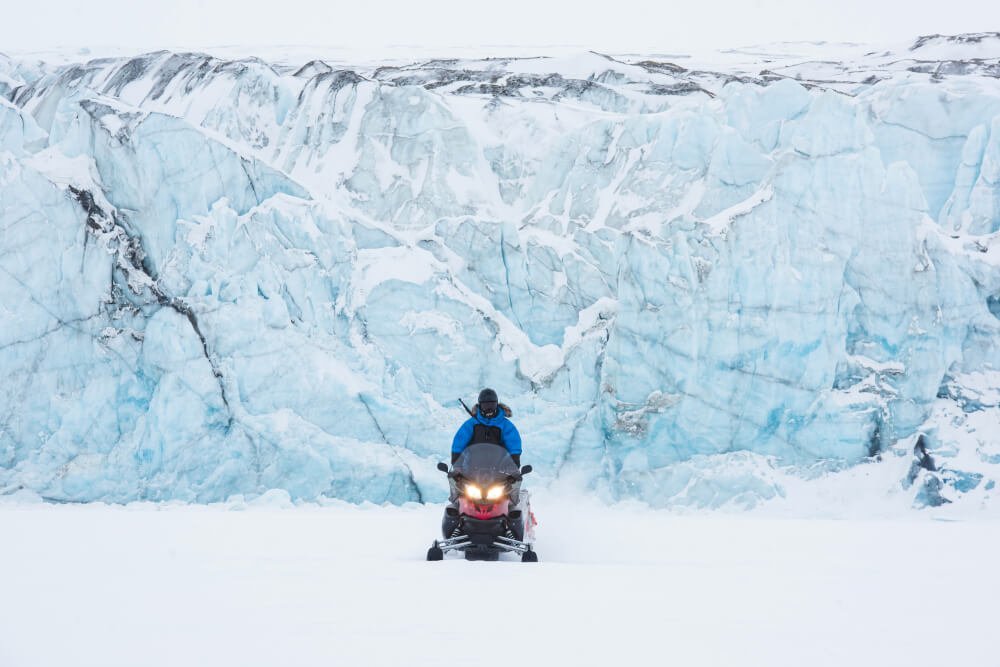
As a result, there is a ton of sea ice and glaciers here, making this the wildest (and coldest) part of the Svalbard archipelago and where you are most likely to see polar bears.
This is not a ride through peaceful trails but rather an active, all-day adventure that will leave you exhilarated (and exhausted).
Expect to travel at least 150 kilometers and for it to take the entirety of a day. On her tour, Megan did not see any polar bears, but she still ranks it as her favorite Svalbard adventure she’s ever done.
Go dog sledding, night or day

- When: All winter
One of the most incredible things you can do in winter in Svalbard is go on a dog sledding trip — many different ways, in fact, depending on the time of year, how much daylight you have, if there’s a lot of snow on the ground, and if there’s anywhere cool you want to go, too.
While doing the ice cave tour of Svalbard by snowmobile, I was surprised to see a few teams of dog sleds roll up right to the same place as we were!
Since I love dog sledding so much (and have done it in four places — Tromsø, Alta, Rovaniemi, and Abisko), I found myself briefly regretting going by snowmobile instead of by dog sled.
If you go dog sledding in Svalbard in the winter, you can have several different types of experiences.
During the season, when you have enough daylight or twilight, as well as enough snow, you can do a variety of dog sled rides through a few different landscapes of Svalbard.
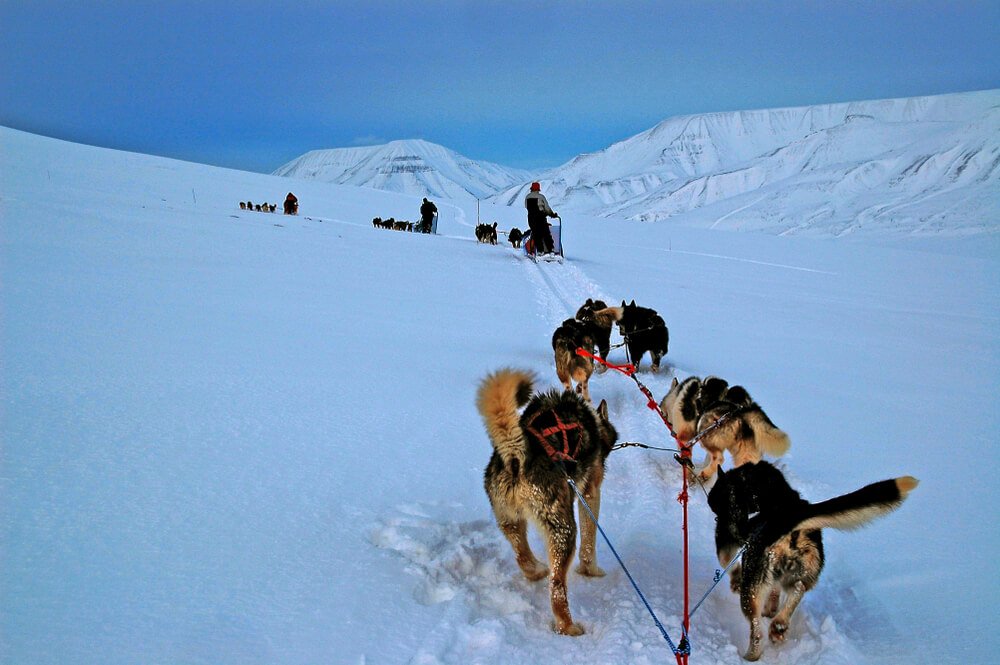
If you don’t want to go to the ice caves, you can also go around in some of the more accessible, less hilly areas around Longyearbyen, like Bolterdalen and Adventdalen.
If you’re visiting Svalbard during the complete darkness of the Polar Night season, you can also do combination dog sled and aurora tours… at any time of day or night!
Here are a few different dog sled tours you can pick from:
- Polar night dog sled with chance of Northern lights
- Dog sledding to the ice caves
- Dog sledding in Bolterdalen
Take a photo with the polar bear sign
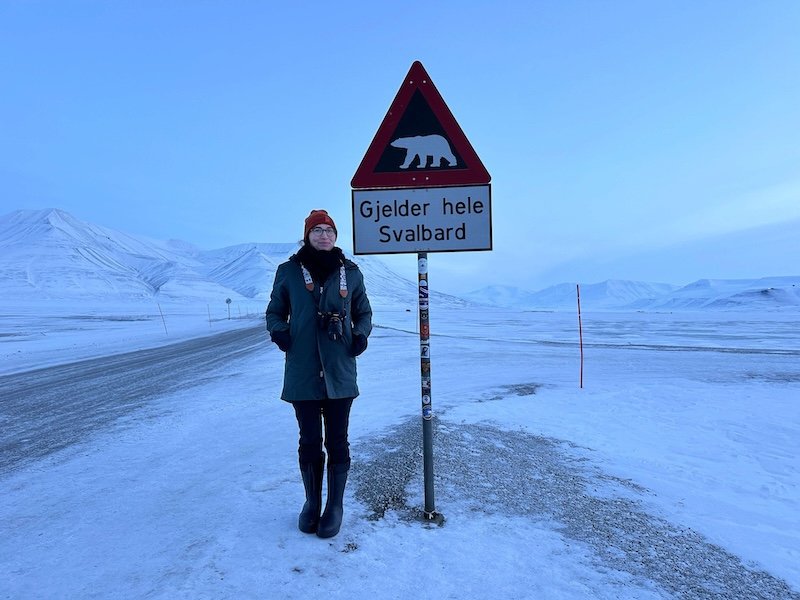
- When: All winter, but better photos in twilight or daylight
Besides the typical colorful houses of Longyearbyen, the other most iconic photo of Svalbard is the polar bear danger sign, which can be found on the outskirts of town.
We visited it during our Arctic wildlife photography trip as we made our way towards the abandoned mine area. It won’t take you too long to see it, but it is a great photo souvenir of Svalbard!
Go on an icy boat cruise

- When: Depends on the sea ice, but some boats start again mid-February
Again, this is another tour I could not do because I visited Svalbard too early in the winter season to enjoy all of its best activities.
If I had to pick the best time for Svalbard, late February is better than mid-February, and March is even better than February. It’s unbelievable what just a few weeks will do in a place that changes as rapidly as Svalbard!
Your wildlife-focused boat tours and ones that include a sea kayaking component typically start up again in polar summer, but my friend Megan clued me in on a little hack. You can go on a boat cruise with Henningsen Transport, which begins running its boats as soon as it is safe to hit the seas!
You can take the Glacier Cruise they offer on Fridays, as early as mid-February. They also provide transportation to Pyramiden and Barentsburg, but there is no guarantee you can dock (and in the case of Pyramiden, it is all but a certainty that you can’t until at least June).
However, these are towns owned by Russian state-owned mining companies. As a result of the war in Ukraine, Visit Svalbard does not promote them out of solidarity with Ukraine. Whether or not you choose to visit is up to you but I leave you this information to make your own choices!
Take a tour of a now-defunct coal mine

- When: All winter
Svalbard is slowly trying to shift away from its mining roots, with the last mine in Longyearbyen planned to close in 2025. But it still values its mining history, as the Arctic island shifts more towards tourism instead of mining as a sustainable economy for the future.
You can visit a former mine, Gruve 3, which was shut down in 1993. This mine is located on the outskirts of Longyearbyen on a Gruve 3 Mine Tour near the Global Seed Vault.
The tour lasts about 3 hours and includes transportation and a full guided tour including equipment like coveralls, headlamp, and helmet. Just be sure to dress warmly as it is very cold in the mine in the winter!
Go on a polar night ATV ride
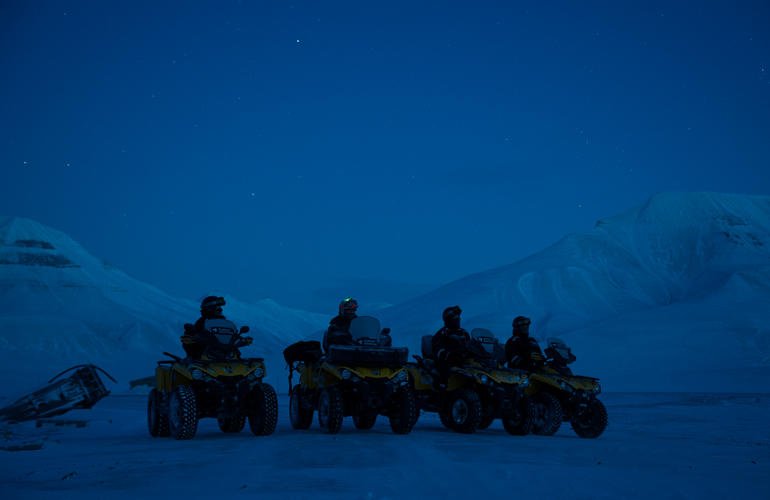
- When: November
There’s a brief period of time during polar night when there’s no daylight but there’s also not enough snow to safely snowmobile around Longyearbyen.
Luckily, no one in Svalbard just sits on a problem without trying to solve it: this is a hardy Arctic community where people come up with solutions, not complaints.
If you happen to plan your Svalbard trip for November, you can go on an ATV ride in search of the Northern lights, checking out frozen ice formations and other cool sights under the polar night sky.
This is the same tour company I did my Northern lights snowmobile tour with and I can highly recommend them if you arrive in Svalbard before snowmobile season starts.
Where to Stay in Svalbard

During my trip to Svalbard we stayed at the charming Svalbard Hotell Polfaren, which had spacious rooms and a really cozy lobby with a fireplace roaring at all times and 24/7 free coffee, which I appreciated in the darkness of winter.
It’s a great mid-range option with prices right smack-dab in the middle of what’s normal for Svalbard. In off-season we paid about $180 USD per night for a double room; in high season, expect to pay more like $250-300 USD a night.
If Polfaren is booked up, there’s also The Vault, another branch of the Hotell Svalbard, located right across the street and offering all the same amenities.
For a slightly nicer option, Funken Lodge is a gorgeous boutique hotel locate just a short walk from downtown.
The rooms are more modern and stylish, but it’s not that much more expensive than other offerings, typically around $250-300 USD per night. It’s also home to one of the best restaurants in Svalbard!
If you’re trying to stick to a budget in Svalbard, it’s not easy… but there are some more affordable accommodation choices, like Coal Miners Cabins, where private rooms with a shared bathroom start around $100 USD per night.
Winter Festivals and Events in Svalbard
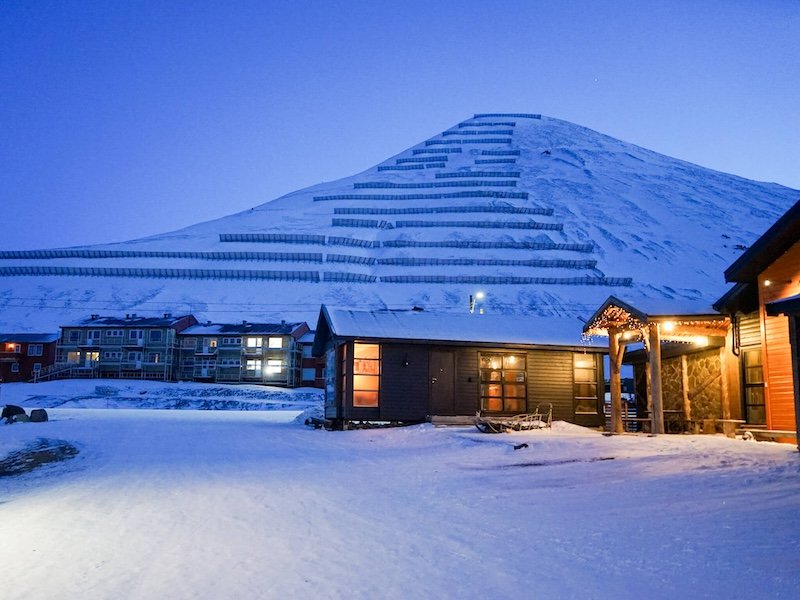
There are a number of winter festivals and fun events in Longyearbyen to make the long, cold winter just a little more pleasant.
The dates change every year and aren’t yet determined for the 2024-2025 season, but the approximate timeframe should remain the same, so I’ll just give an outline for when you might expect them to occur.
- October: Taste Svalbard food festival in the beginning of the month, Dark Season Blues Festival at the end of the month
- November: Christmas Hotel at Basecamp Explorer reopens mid-month
- December: Torchlit walk to “Santa’s Mine” and lighting of the Christmas tree on the first Sunday of Advent
- February: Polarjazz Festival at the beginning of the month, Arctic Chamber Music Festival at the end of the month
- March: Sun Festival Week is the first week of March every year as the sun returns to Longyearbyen
- April: Svalbard Ski Marathon occurs around mid-month, close to the midnight sun’s return
What to Wear in Svalbard in Winter
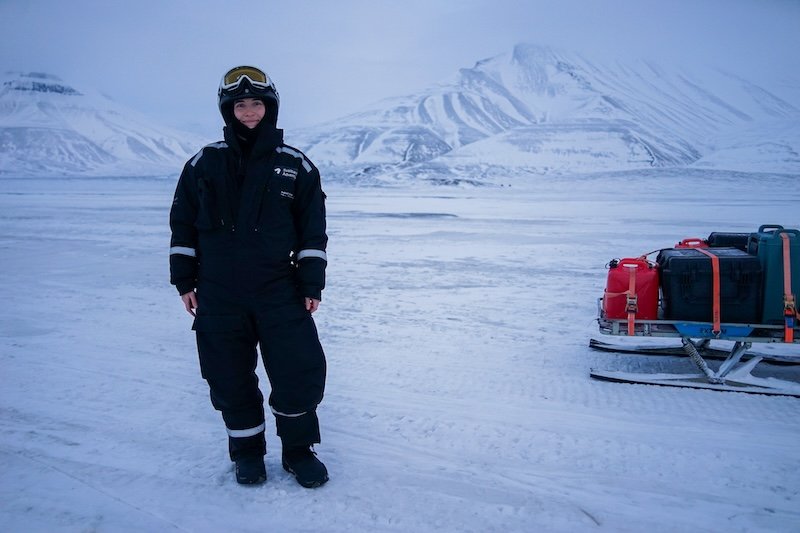
This post is already so long so instead of going into a huge amount of detail, I’m going to refer you to my Svalbard packing list post here. But here’s a quick bullet point list of what an average “Svalbard winter outfit” should entail!
- Very warm, waterproof parka
- Wool base layers
- Waterproof pants or ski pants
- Wool sweaters
- Neck gaiter and/or scarves
- Warm hat
- Wool socks
- Snowboots
- Mittens and photography gloves
Allison Green is a former teacher who has been travel blogging since 2016. She has a Masters in Teaching and a B.A. in English and Creative Writing. Her blog posts merge her background as an educator with her experience traveling to 70+ countries to encourage ethical, meaningful travel. She has been a speaker at the World Travel Writers Conference and her writing, photography, and podcasting work has appeared in National Geographic, CNN Arabic, CBC Canada, and Forbes, amongst others. Now a full-time traveler, she has lived in Prague, Sofia, New York City, and the San Francisco Bay Area.